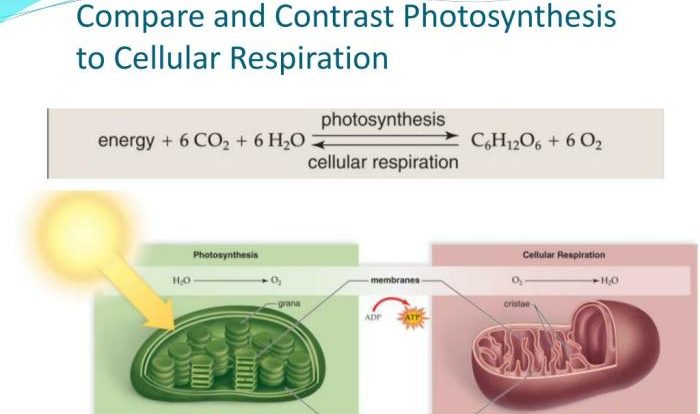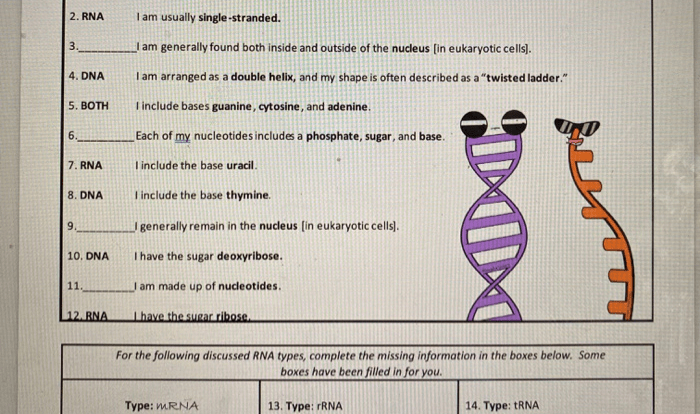Anatomy of a frog worksheet – Embark on a captivating journey into the intricate world of frog anatomy with our comprehensive worksheet. Dive into the fascinating details of a frog’s body structure, from its external features to its internal organs, skeletal system, and more.
Our meticulously crafted worksheet provides a thorough understanding of the frog’s unique adaptations and physiological processes. Prepare to be amazed as we uncover the secrets of this remarkable amphibian.
Frog Anatomy Overview
Frogs are amphibians with unique anatomical features that allow them to thrive in both aquatic and terrestrial environments. Understanding their anatomy provides insights into their adaptation and survival strategies.
External Features
Frogs have a dorsoventrally flattened body with a distinct head, trunk, and limbs. Their head houses large, protruding eyes, nostrils, and a wide mouth. The trunk is short and robust, containing the internal organs. Frogs possess four limbs, with the forelimbs being shorter than the hindlimbs.
Their skin is smooth and moist, often containing glands that secrete mucus for protection and respiration.
Internal Organs
Internally, frogs have a well-developed digestive system, including a mouth, esophagus, stomach, intestines, and cloaca. Their respiratory system consists of lungs and a skin that facilitates cutaneous respiration. The circulatory system is single, with a heart that pumps blood throughout the body.
Frogs possess a urinary system with kidneys and a cloaca for waste elimination. Additionally, they have a reproductive system that varies depending on the species.
Frog Skeletal System
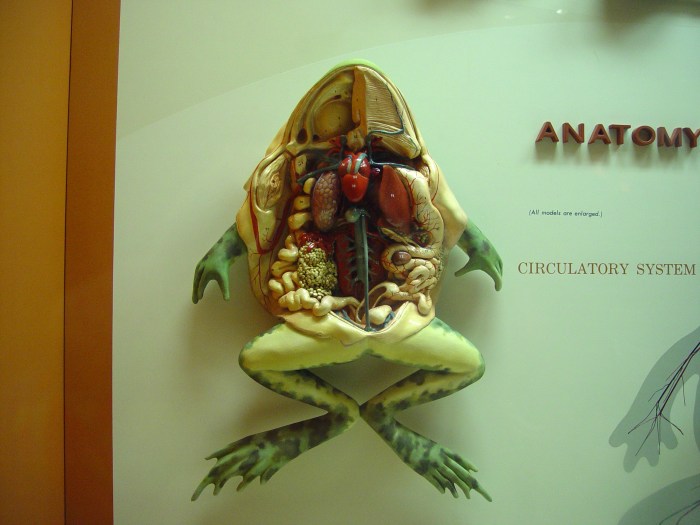
The skeletal system of a frog is an intricate framework that provides support, protection, and enables movement. It consists of various types of bones that are organized into a specialized structure to facilitate the frog’s unique adaptations and behaviors.
Types of Bones in a Frog
The frog’s skeletal system comprises several types of bones, each with distinct functions:
-
-*Long bones
These are elongated and cylindrical, found in the limbs and provide support and facilitate movement.
-*Short bones
These are cube-shaped or irregular in shape, located in the wrists and ankles, and aid in flexibility and movement.
-*Flat bones
These are thin and broad, such as those in the skull and shoulder girdle, providing protection and attachment points for muscles.
-*Irregular bones
These have complex shapes and are found in the vertebrae and pelvic girdle, offering support and articulation.
Support and Movement
The frog’s skeletal system provides essential support for the body. The bones act as a rigid framework, preventing collapse and providing protection for internal organs. Additionally, the skeletal system enables movement through the articulation of bones at joints. Muscles attach to the bones, and their contractions generate force that causes movement.
The frog’s skeletal system is thus crucial for its ability to hop, swim, and perform other movements.
Frog Muscular System
The muscular system of a frog is a complex network of muscles that work together to produce movement. Muscles are composed of bundles of muscle fibers, which are long, thin cells that can contract and relax. When a muscle fiber contracts, it shortens, pulling on the tendons that attach it to bones.
This causes the bones to move, resulting in movement.
Muscles work in pairs, with one muscle contracting while the other relaxes. This allows for smooth, controlled movement. For example, when a frog jumps, the muscles in its legs contract, pushing the frog into the air. The muscles in its back then relax, allowing the frog to land safely.
Major Muscle Groups
The major muscle groups in a frog’s body include:
- Pectoralis muscles:These muscles are located on the chest and are responsible for moving the forelimbs.
- Dorsal muscles:These muscles are located on the back and are responsible for moving the hindlimbs.
- Abdominal muscles:These muscles are located on the abdomen and are responsible for compressing the body and expelling air from the lungs.
- Leg muscles:These muscles are located on the legs and are responsible for jumping, swimming, and walking.
Frog Nervous System
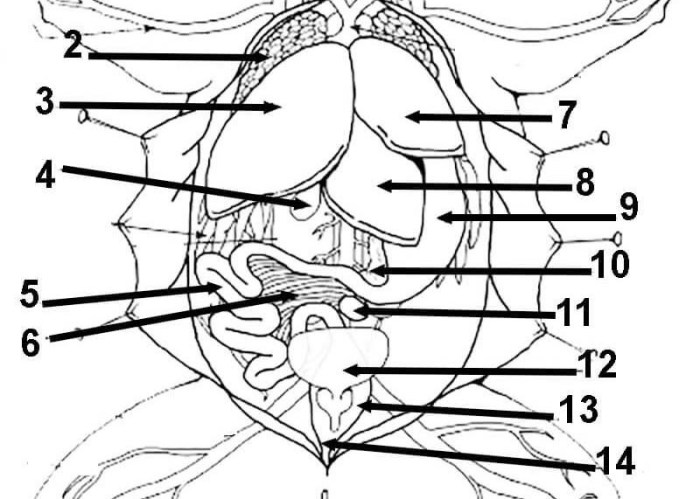
The nervous system of a frog is a complex network of specialized cells that coordinates the activities of the body and responds to stimuli from the environment. It is composed of the central nervous system (CNS) and the peripheral nervous system (PNS).
Frog Brain
The frog’s brain is enclosed within the skull and is divided into several regions, each with specific functions:
- Cerebrum:Responsible for higher-level functions such as learning, memory, and voluntary movement.
- Diencephalon:Includes the thalamus, which relays sensory information to the cerebrum, and the hypothalamus, which controls body temperature, hunger, and thirst.
- Mesencephalon:Contains the optic tectum, which processes visual information, and the tegmentum, which controls eye movements.
- Metencephalon:Consists of the cerebellum, which coordinates muscle movements, and the pons, which relays information between the cerebrum and the spinal cord.
- Myelencephalon:Contains the medulla oblongata, which controls vital functions such as breathing, heart rate, and digestion.
Frog Spinal Cord
The spinal cord is a long, cylindrical structure that extends from the brain and runs through the vertebral column. It serves as a communication pathway between the brain and the rest of the body, transmitting sensory information to the brain and motor commands from the brain to the muscles and organs.
Nervous System Control
The frog’s nervous system plays a crucial role in controlling the body and behavior by:
- Receiving and processing sensory information from the environment.
- Integrating information and making decisions.
- Sending motor commands to muscles and organs.
- Regulating body functions such as breathing, heart rate, and digestion.
- Controlling behavior, including reproductive, feeding, and social interactions.
Frog Circulatory System
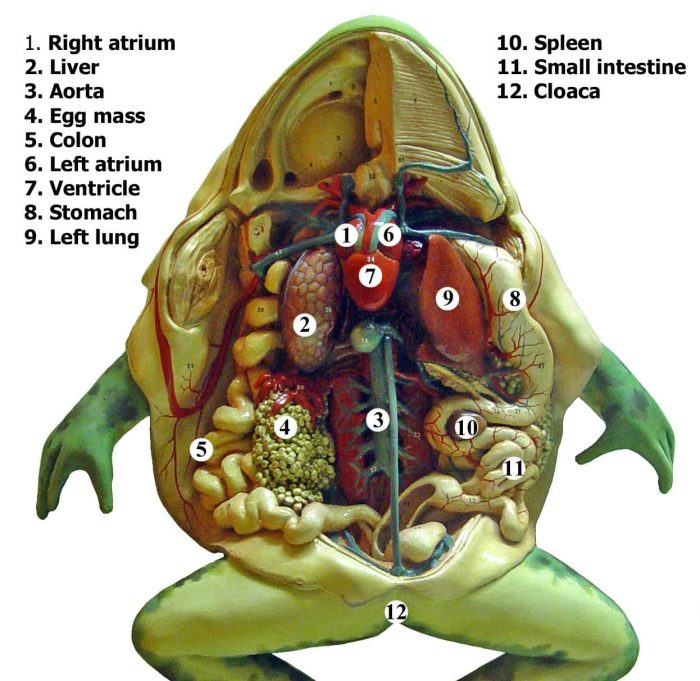
The frog’s circulatory system is a closed, double circulatory system, meaning that blood flows through vessels and does not come into direct contact with the body’s tissues. The heart pumps oxygenated blood to the body’s tissues and deoxygenated blood back to the heart.
The frog’s heart is divided into three chambers: two atria and one ventricle. The right atrium receives deoxygenated blood from the body, while the left atrium receives oxygenated blood from the lungs. The ventricle pumps blood out to the body.
The frog’s circulatory system also includes a network of blood vessels. Arteries carry oxygenated blood away from the heart, while veins carry deoxygenated blood back to the heart. Capillaries are small blood vessels that allow for the exchange of oxygen and carbon dioxide between the blood and the body’s tissues.
Blood Vessels
The frog’s circulatory system includes three types of blood vessels: arteries, veins, and capillaries.
- Arteriescarry oxygenated blood away from the heart to the body’s tissues.
- Veinscarry deoxygenated blood back to the heart from the body’s tissues.
- Capillariesare small blood vessels that allow for the exchange of oxygen and carbon dioxide between the blood and the body’s tissues.
Frog Respiratory System
Frogs, like other amphibians, have a unique respiratory system that allows them to breathe both in water and on land. This system consists of lungs, a trachea, and a pair of nostrils.
When a frog is in water, it breathes through its skin. The skin is thin and moist, which allows oxygen to pass through it and into the bloodstream. However, when a frog is on land, it must use its lungs to breathe.
The lungs are located in the frog’s chest cavity, and they are connected to the trachea. The trachea is a tube that carries air from the nostrils to the lungs.
Dissecting the intricacies of a frog’s anatomy is a valuable exercise in scientific exploration. While delving into the complexities of amphibian biology, why not test your literary acumen with a quick To Kill a Mockingbird quiz ? Return to the dissection table refreshed and ready to unravel the mysteries of the frog’s fascinating anatomy.
Lungs
The lungs are the primary organs of respiration in frogs. They are located in the chest cavity, and they are divided into two lobes. The lobes are filled with air sacs, which are lined with capillaries. The capillaries are tiny blood vessels that allow oxygen to pass from the air sacs into the bloodstream.
The lungs are also responsible for removing carbon dioxide from the bloodstream.
Trachea
The trachea is a tube that carries air from the nostrils to the lungs. It is lined with cilia, which are small, hair-like structures that help to move air through the trachea.
Nostrils
The nostrils are located on the top of the frog’s head. They are responsible for taking in air from the environment. The nostrils are lined with mucus, which helps to trap dust and other particles from entering the respiratory system.
Frog Digestive System
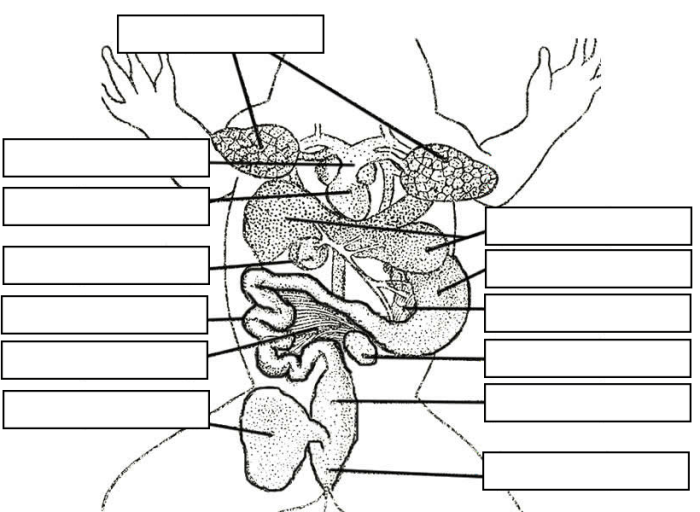
The digestive system of a frog is a complex and efficient system that allows the frog to break down and absorb nutrients from its food. The frog’s digestive system consists of a mouth, esophagus, stomach, small intestine, large intestine, and cloaca.
Mouth
The frog’s mouth is equipped with small, sharp teeth that help it to grip and tear its prey. The frog’s tongue is long and sticky, and it uses it to capture prey and move it into its mouth.
Esophagus
The esophagus is a short tube that connects the mouth to the stomach. The esophagus helps to move food from the mouth to the stomach.
Stomach
The stomach is a muscular organ that secretes digestive juices to break down food. The stomach also churns the food, which helps to further break it down.
Small Intestine
The small intestine is a long, coiled tube that is responsible for the majority of nutrient absorption. The small intestine is lined with villi, which are small, finger-like projections that increase the surface area for nutrient absorption.
Large Intestine
The large intestine is a shorter, wider tube that is responsible for absorbing water and electrolytes from the food. The large intestine also stores waste products until they are excreted.
Cloaca
The cloaca is a common opening that serves as the outlet for the digestive, urinary, and reproductive systems. The cloaca is located at the posterior end of the frog’s body.
Frog Excretory System: Anatomy Of A Frog Worksheet
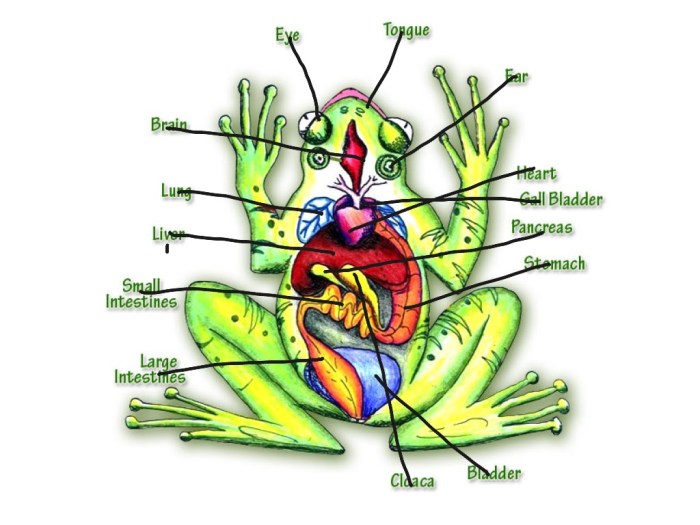
The frog’s excretory system is responsible for removing waste products from the body. It consists of the kidneys, ureters, urinary bladder, and cloaca.
The kidneys filter waste products from the blood and produce urine. The ureters carry the urine from the kidneys to the urinary bladder. The urinary bladder stores the urine until it is released through the cloaca.
Kidneys, Anatomy of a frog worksheet
- The kidneys are located in the abdominal cavity, one on each side of the backbone.
- Each kidney is made up of millions of tiny filtering units called nephrons.
- The nephrons filter waste products from the blood and produce urine.
Ureters
- The ureters are two tubes that carry the urine from the kidneys to the urinary bladder.
- The ureters are lined with cilia, which help to move the urine along the tubes.
Urinary Bladder
- The urinary bladder is a sac-like organ that stores the urine until it is released through the cloaca.
- The urinary bladder is lined with a waterproof membrane that prevents the urine from leaking out.
Cloaca
- The cloaca is a common opening that serves as the outlet for the digestive, urinary, and reproductive systems.
- The cloaca is lined with a sphincter muscle that controls the release of urine.
Frog Reproductive System
The frog’s reproductive system is designed for external fertilization, a process that occurs outside the body of the female. This system consists of various organs that play crucial roles in reproduction, including the gonads, reproductive ducts, and accessory glands.
Gonads: Frogs are dioecious, meaning they have separate sexes. Male frogs possess testes, which produce sperm, while female frogs have ovaries, which produce eggs.
Male Reproductive Organs
- Testes: The testes are located in the abdominal cavity and produce sperm. During the breeding season, the testes enlarge and produce millions of sperm cells.
- Vasa Deferentia: These are ducts that transport sperm from the testes to the cloaca.
- Seminal Vesicles: These glands secrete seminal fluid, which nourishes and protects the sperm.
- Cloaca: This is a common chamber that receives urine, feces, and reproductive products. It also serves as an outlet for these substances.
Female Reproductive Organs
- Ovaries: The ovaries are located in the abdominal cavity and produce eggs. During the breeding season, the ovaries enlarge and contain numerous developing eggs.
- Oviducts: These are ducts that transport eggs from the ovaries to the cloaca.
- Uterus: In some female frogs, the oviducts are expanded into a uterus, where the eggs are fertilized and develop.
- Cloaca: The cloaca receives eggs from the oviducts and serves as an outlet for them.
Reproduction in Frogs
Reproduction in frogs typically occurs during the breeding season, which is often triggered by environmental cues such as rainfall or changes in temperature. Male frogs attract females by producing vocalizations, and females select mates based on factors such as size and vocalizations.
During mating, the male frog clasps the female in a position known as amplexus. The female releases her eggs into the water, and the male fertilizes them externally by releasing sperm over them. The fertilized eggs develop into tadpoles, which undergo metamorphosis to transform into adult frogs.
FAQ Guide
What is the purpose of a frog’s webbed feet?
Webbed feet enhance a frog’s ability to swim and maneuver in aquatic environments.
How does a frog’s skin contribute to its survival?
The frog’s skin plays a crucial role in respiration, water absorption, and protection from external threats.
